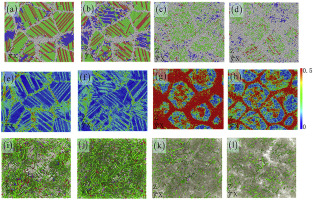当前位置:
X-MOL 学术
›
Intermetallics
›
论文详情
Our official English website, www.x-mol.net, welcomes your feedback! (Note: you will need to create a separate account there.)
Effects of temperature and strain rate on plastic deformation mechanisms of nanocrystalline high-entropy alloys
Intermetallics ( IF 4.4 ) Pub Date : 2020-05-01 , DOI: 10.1016/j.intermet.2020.106741 Li Li , Haotian Chen , Qihong Fang , Jia Li , Feng Liu , Yong Liu , Peter K. Liaw
Intermetallics ( IF 4.4 ) Pub Date : 2020-05-01 , DOI: 10.1016/j.intermet.2020.106741 Li Li , Haotian Chen , Qihong Fang , Jia Li , Feng Liu , Yong Liu , Peter K. Liaw

|
Abstract The nanocrystalline high-entropy alloys (HEAs) can be regarded as ideal substitution materials for use in aero engines due to their outstanding mechanical properties. Owing to the crucial importance on the evaluation of mechanical properties in nanocrystalline HEAs, the identification of the plastic deformation mechanism remains a challenging topic. Considering the fact that nanocrystalline HEAs suffer from the high-temperature service, the roles of strain rate and temperature on their deformation characteristics should be examined. Here, we report the impact of strain rate and temperature on the mechanical properties and deformation behaviors of nanocrystalline HEAs. This issue was investigated by a series of molecular-dynamics tensile tests at different strain rates ranging from 5 × 107 to 1 × 1010 s−1 and temperatures ranging from 10 to 1,200 K. The results show that the dislocation slip controls the preferred deformation mechanism at low temperatures and high strain rates. When the temperature rises and strain rate reduces, grain-boundary sliding dominates the primary deformation mechanism at elevated temperatures. Moreover, the occurrence of the face-centered-cubic (fcc) to body-centered-cubic (bcc) phase transformation can effectively enhance the plasticity of HEAs. The synergistically-integrated experimental and modeling efforts at the nanoscale will help understand, control, and optimize the mechanical behaviors of nanocrystalline HEA systems, thereby enabling the development of advanced nanocrystalline HEAs.
中文翻译:

温度和应变速率对纳米晶高熵合金塑性变形机制的影响
摘要 纳米晶高熵合金(HEAs)因其优异的机械性能而被视为航空发动机的理想替代材料。由于纳米晶 HEA 机械性能评估的重要性,塑性变形机制的识别仍然是一个具有挑战性的课题。考虑到纳米晶 HEA 经受高温服务的事实,应检查应变速率和温度对其变形特性的作用。在这里,我们报告了应变速率和温度对纳米晶 HEAs 的机械性能和变形行为的影响。通过在 5 × 107 到 1 × 1010 s-1 的不同应变率和 10 到 1,200 K 的温度范围内进行一系列分子动力学拉伸试验研究了这个问题。结果表明位错滑移控制了首选的变形机制在低温和高应变率下。当温度升高和应变率降低时,晶界滑动在高温下主导主要变形机制。此外,面心立方 (fcc) 到体心立方 (bcc) 相变的发生可以有效提高 HEAs 的可塑性。纳米级协同集成的实验和建模工作将有助于理解、控制和优化纳米晶 HEA 系统的机械行为,
更新日期:2020-05-01
中文翻译:

温度和应变速率对纳米晶高熵合金塑性变形机制的影响
摘要 纳米晶高熵合金(HEAs)因其优异的机械性能而被视为航空发动机的理想替代材料。由于纳米晶 HEA 机械性能评估的重要性,塑性变形机制的识别仍然是一个具有挑战性的课题。考虑到纳米晶 HEA 经受高温服务的事实,应检查应变速率和温度对其变形特性的作用。在这里,我们报告了应变速率和温度对纳米晶 HEAs 的机械性能和变形行为的影响。通过在 5 × 107 到 1 × 1010 s-1 的不同应变率和 10 到 1,200 K 的温度范围内进行一系列分子动力学拉伸试验研究了这个问题。结果表明位错滑移控制了首选的变形机制在低温和高应变率下。当温度升高和应变率降低时,晶界滑动在高温下主导主要变形机制。此外,面心立方 (fcc) 到体心立方 (bcc) 相变的发生可以有效提高 HEAs 的可塑性。纳米级协同集成的实验和建模工作将有助于理解、控制和优化纳米晶 HEA 系统的机械行为,



























 京公网安备 11010802027423号
京公网安备 11010802027423号